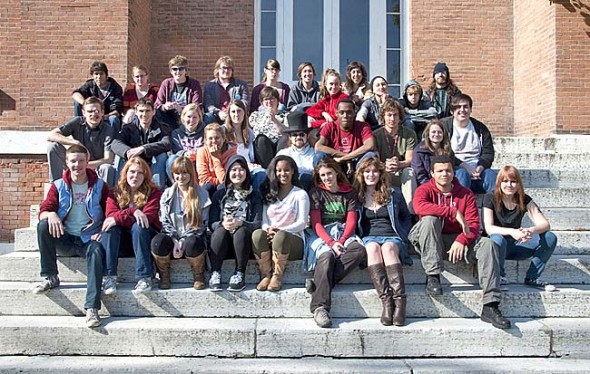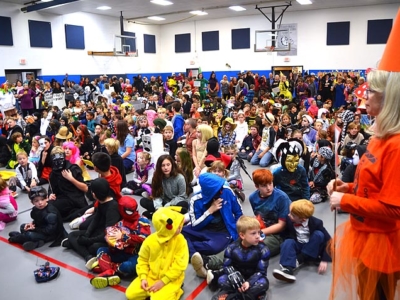
The first class of the revived Antioch College gathered on the steps of Main Building at the start of their year. After nine months and three challenging terms, students said they felt exhausted and overwhelmed, yet enthused with a sense of accomplishment. The next class arrives in October. (submitted Photo by Dennie Eagleson)
Year of challenge for class of ’15
- Published: August 9, 2012
For the first class of the revived Antioch College, the last nine months have been intense.
Rachael Smith fought chiggers and poison ivy on her co-op job pulling invasive species in the Glen Helen Nature Preserve. Maryann Otuwa was one of six students who worked 10 hours a day this summer restoring a ceiling mural at a synagogue in Poland. Marianthe Bickett was sore for much of the first week at the college farm — her first ever full-time job.
Courses have been tough, local co-op jobs have come with major responsibility, and the first 33 students have taken seriously their role in remaking a college.
“We’re never bored here because we’re too busy to be bored,” said Smith, one of several students who said they felt exhausted and overwhelmed, yet enthused with a sense of accomplishment at the start of the summer term.
Together with faculty and staff, students have crafted a new governance structure, pushed for a better academic model and worked through the first-year kinks for the benefit of next year’s class of 75 students arriving October 2. The work has been daunting; philosophy professor Lew Trelawney-Cassidy has called it “a syndrome of too muchness.” And yet students still found time — as typical college students do — to hang out and have fun.
“It’s class, homework, stress out, sleep, eat and repeat,” Otuma said of the rhythm of academic terms. But there is also the occasional dance party in an empty hallway or improvised slip ‘n’ slide in the quad, she added.
That students are investing in their institution is paying dividends not just for Antioch, but for the students themselves, said Vice President for Academic Affairs Hassan Rahmanian.
“[The students] are not passive receivers of what we are offering, they feel they are very much a part of these changes and feel ownership of these changes,” Rahmanian said. He called their participation a “catalyst for maturation,” and has seen the students transform far more quickly at the new Antioch than in the previous incarnation.
“Even in this short period of time there are many students you can see are a different person,” Rahmanian said.
The historic liberal arts college, in its first full year with students since temporarily closing in 2008, received mostly positive reviews from the first batch of students, who praised fulfilling co-op jobs, close relationships with professors and the satisfaction of leaving their mark on the institution. And all were excited that they would soon become upperclassmen with the arrival of a new freshman class this fall.
Co-ops ‘pivotal for learning’
Smith’s forays into the Glen during co-op, though made interesting by nature’s challenges, was actually “an incredible experience,” she said. Working with land manager George Bieri to restore the Glen by pulling honeysuckle and bittersweet and planting native species, Smith learned a lot about the local ecosystem.
“This is a new ecosystem for me,” said Smith, who hails from northern California. “My co-op gave me an appreciation for where I’m going to be living for the next few years.”
Out on the college farm, Bickett’s interest in holistic healthcare was bolstered as she learned about the various uses of medicinal plants from farm manager Kat Christen. Anya Gandy, who hopes to go into politics, was happy to help raise money for the college’s annual fund for her co-op, since “fundraising is so critical to politics.”
Other students were surprised by what they learned on co-op. Diana Lopez worked with Amy Crawford at the Yellow Springs Senior Center’s Home Assistance Program. The Mexico native expected to improve her English, but was surprised at how much she enjoyed visiting with older people.
“I knew I wanted to have connection with people but I never thought it was with elders,” Lopez said, who might change her major from criminal psychology to geriatrics.
Dustin Mapel took on major responsibility as an inspector with the Springfield Department of Engineering’s Storm Water Division. He inspected 115 sites throughout the city, from schools to Taco Bells, along with 300 point sources of pollution along Buck Creek. But he also spent time in a cubicle and ended up learning a lot about office etiquette.
“I learned how to get ahead in an office,” Mapel said. “Keep your desk messy while you’re there and clean while you’re not.”
Mapel was one of several students who had to step up at their co-op, said Susan Eklund-Leen, dean and professor of Cooperative Education.
“That’s what’s exciting about a co-op program, rather than an internship where they don’t often have mission-centered work for the students,” Eklund-Leen said. One student worked his co-op in her office, helping with accreditation issues, and excelled, she said.
“He understood the urgency and that the future of the college would rely on what he did,” she said.
Other students worked at a K-12 art gallery, an art therapy non-profit, Planned Parenthood, Yellow Springs Arts Council, Home, Inc., WYSO public radio, Yellow Springs schools, Yellow Springs Kids Playhouse and for local documentarians Julia Reichert and Steve Bognar.
But some students had less-than-ideal co-op experiences. Elijah Blanton, who worked at the front desk at the Boonshoft Museum of Discovery in Dayton, said it was “not the job I wanted but the place I wanted to be.” Another student, working at an area farm, found the work to be drudgery. And several said that they were somewhat disappointed to have to stay local for their first co-op.
Eklund-Leen said that next summer first-year students can venture off for their co-op, as this class was only kept local to host prospective students visiting campus. And she said that sometimes co-ops that don’t work out can be more “pivotal for learning” than those that do.
“We had students who absolutely loved their job, and a few others who may not have been in the most ideal work situation for them,” Eklund-Leen said. “It’s hard, but it helps them to understand how to make good choices … if it was a bad match, they’ve learned a lot.”
Academics remain challenging
Even with the stress of working full-time, co-op term was far easier than academic terms, several students said. That’s because Antioch’s first set of classes have been every bit as “rigorous” as President Mark Roosevelt promised.
Rahmanian, the current vice president for Academic Affairs and a former Antioch professor, credited faculty members for maintaining a high standard for their courses. While in the past there were some tough classes and some easy ones, now every course is demanding, he said.
Some of the difficulty has eased since Antioch abandoned its modified block model, when classes were condensed into five-week periods, in exchange for classes that last a full term.
“It was really intensive and didn’t give our students and faculty enough time for the development [of the subject],” Rahmanian said of the block system. “It was not the learning model we were hoping to have.”
Students agreed that the block system wasn’t working and successfully pushed for the change. That students organized to make the change impressed Smith, who said that even as a good student it was all she could do to turn in her work on time.
“It showed me the strength of this school that we got it changed,” Smith said.
Among students, science classes have been the most popular, according to Rahmanian, a trend that is likely to continue with the incoming class, 25 percent of whom plan to major in the sciences.
But the limited number of options at such a small school has its challenges. Lopez has had to wait three terms to take a math class — her favorite subject. At least one student is concerned that they might not be able to take all of the classes they need for their major.
“I’m worried I won’t get what I need,” said Gandy, who is interested in agricultural politics. Though Antioch is an “exceptional” place, “if I can’t get it here, I’ll go somewhere else,” she said of her courses.
Rahmanian said that choices will be limited at the college for at least the next two to three years, but that adjusting for the size of the faculty, Antioch’s offerings are comparable to other places. On the flip side, students said they appreciated the close relationships with their professors afforded at such a small institution. The student to faculty ratio at Antioch, a distinct advantage over other colleges, is now less than 3:1.
Learning goes beyond
The college experience for Antioch’s first class has not been confined to classroom and co-op. Much learning has taken place beyond, and in the case of the six students who travelled to Poland this summer, it happened far beyond.
The students weren’t on a sight-seeing trip; they went to Sejny, Poland, to help restore a 17th century painted ceiling at a synagogue that was destroyed during World War II. The work was tedious and the subject matter heavy.
Students made their own paint and rabbit-skin glue, spent up to 10 hours each day hard at work painting intricate flowers and other designs and explored their sometimes-mixed emotions about restoring artwork central to the history of another culture.
To Sam Senzek, the experience was like a “cold bucket of water,” as she confronted notions of cultural superiority.
“We’d realized we all went in with an assumed right,” Senzek said of the work. “But we decided that we were facilitating them in telling their story.”
Otuwa learned how to adapt to a new culture and throw herself into the experience, she said. Originally she went there for the adventure, but ended up working hard.
“I realized that if I’m going to do something, I’m going to do it to the best of my ability,” she said.
Back on campus, students grappled with the inherited governance structure throughout the year, coming up with a new model based around small groups made up of faculty, student and staff members. Dean of Community Life Louise Smith said the process was “emergent” and “improvisatory” and is working well. Gandy said students have worked to make sure governance is efficient.
“Our government is designed so everyone has a voice,” she said. “It’s really easy to make yourself heard in a small group.”
Students also developed a clearer elections process, chose a more consensus-based approach over Robert’s Rules of Order, and created a Council of Conveners, where representatives from each small group come together. Overall, Smith has been impressed, and participation in community meetings is high, with 21 of the 29 students now on campus attending the last meeting.
Students have sought excitement and fulfillment in the community of Yellow Springs as well. The Miller Fellows Program, in which students work for local organizations, has created a “meaningful bridge” between campus and community, Smith said. Several students were recently featured in an Emerging Young Artists gallery exhibit at the Yellow Springs Arts Council curated by student Meg Miller. Students have also sought out local activities on their own. Guy Matthews plays in a local flag football league, while Gandy coaches track and cross country at Yellow Springs High School.
With just 33 students on campus and a busy schedule of classes, work and committees, there are few clubs and other formal groups on campus, but students still find ways to have fun. From tossing a Frisbee on the Main Lawn to going on one of the frequent trips sponsored by Community Life (on a recent weekend they were chauffeured to King’s Island, Jungle Jim’s and Caesar’s Creek), life on campus is never dull, students said.
Incoming student Alexander Schlosser, who moved in a few months early, has been particularly enjoying the intellectual stimulation of college life.
“You just walk around and someone is having a groundbreaking discussion,” he said. On a recent Friday night, a long conversation about the Holocaust ensued after listening to music based upon Anne Frank’s diary. Schlosser, who transferred from a large, “big name” university, is much happier at Antioch.
“After orientation [at other schools], you’re just a number,” he said. “People say ‘hi’ to you here — people are more worried about their futures, and their minds.”
The Yellow Springs News encourages respectful discussion of this article.
You must login to post a comment.
Don't have a login? Register for a free YSNews.com account.
Parkinsons.jpg)














No comments yet for this article.